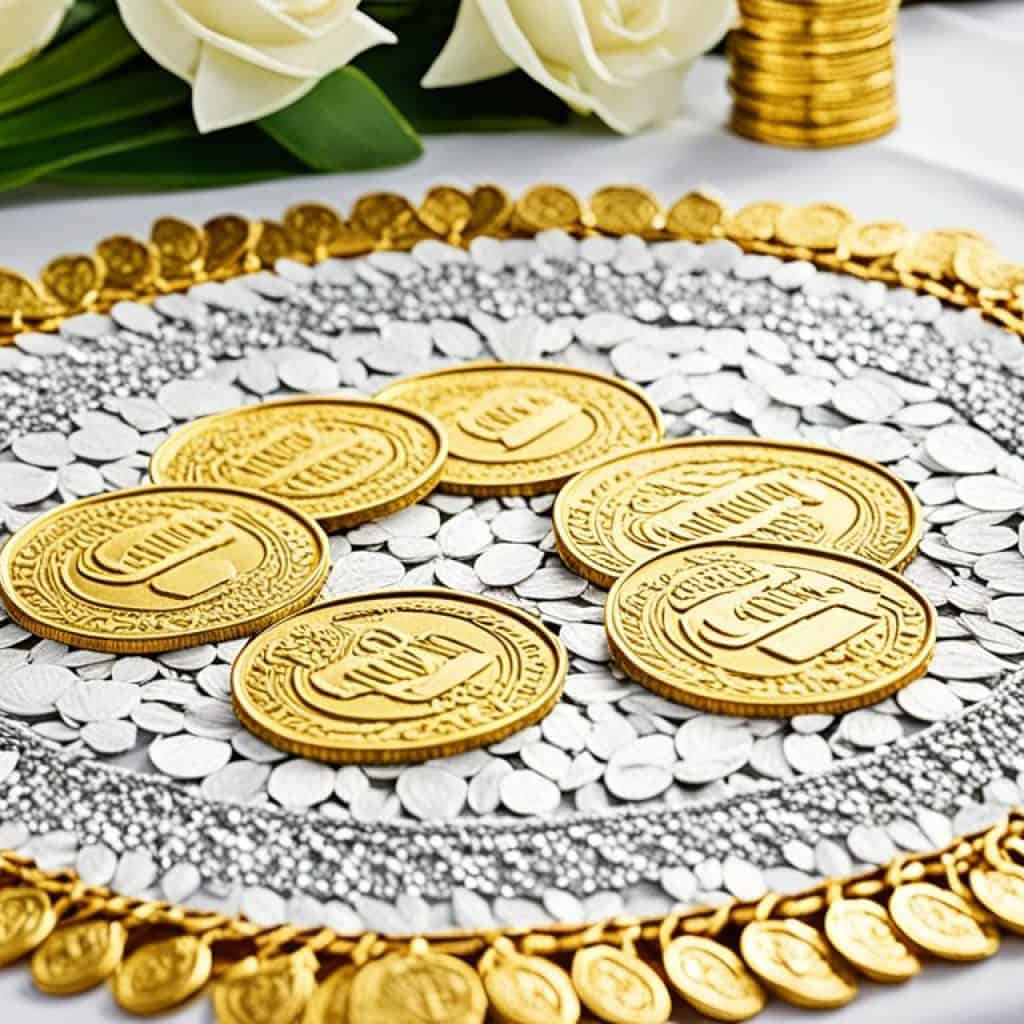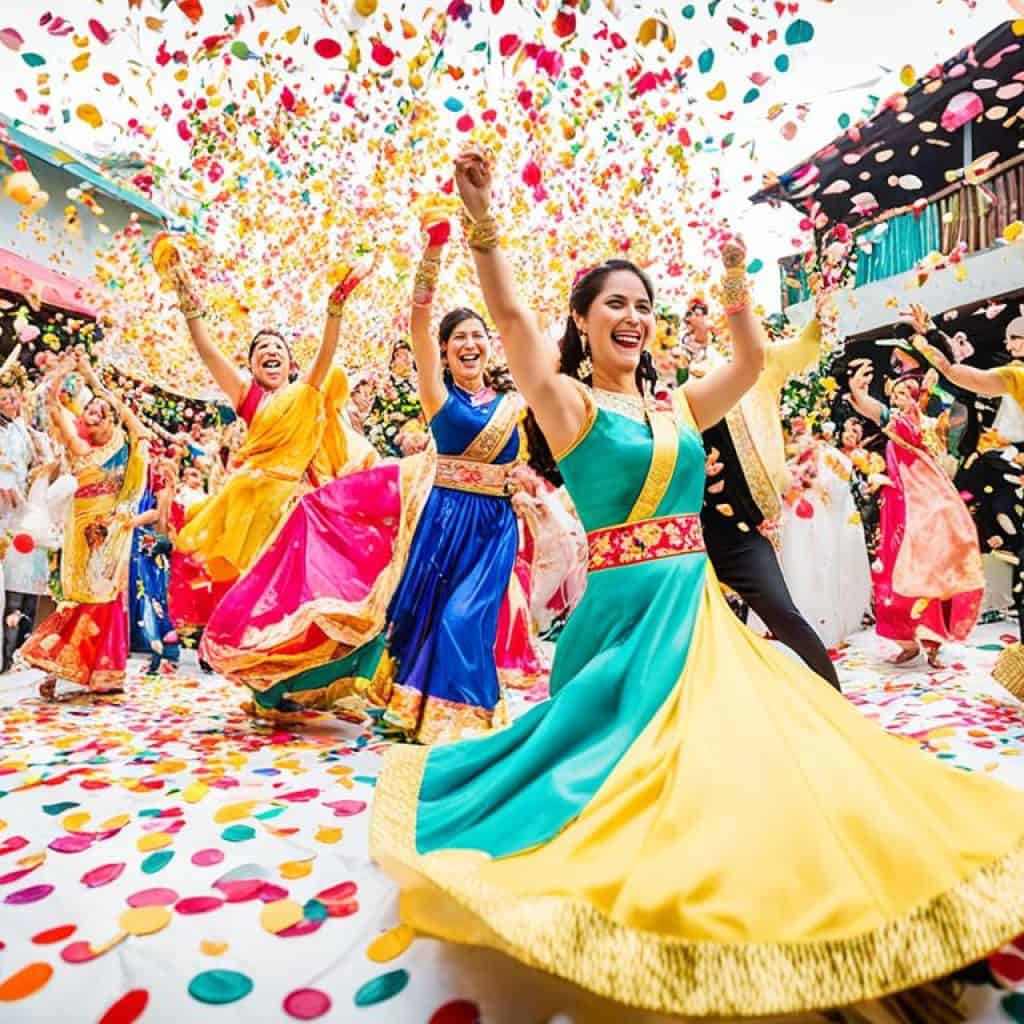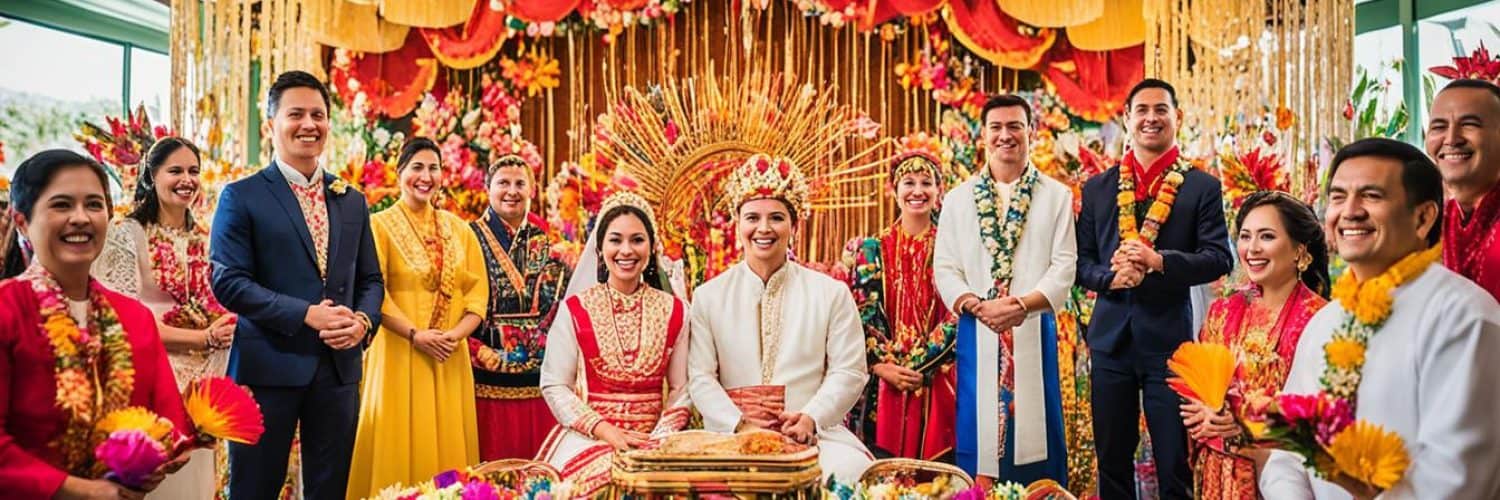Imagine being part of a wedding filled with traditions from centuries ago. Filipino weddings mix the colors of the Philippines1. They combine indigenous, Spanish, American, Chinese, and Islamic cultures into a special event. Every part of a Filipino wedding shows the country’s rich mix of cultures2.
This guide will take you through the unique customs and rituals of Filipino weddings. You’ll see how love, family, and community come together in these celebrations.
Key Takeaways
- Discover the blend of indigenous, Spanish, American, Chinese, and Islamic influences that shape Filipino wedding traditions.
- Explore the significance of family and community in Filipino marriage customs, from the Pamamanhikan to the Handaan reception.
- Learn about unique pre-wedding rituals like the Kasunduan engagement ceremony and the Ifugao Takik dance.
- Understand the symbolic significance of ceremonial objects like the unity candle, cord, and arras coins in Filipino weddings.
- Uncover the cultural roots of the money dance, Ting Hun ceremony, and traditional Filipino wedding attire.
The Significance of Marriage in Filipino Culture
Marriage is very important in Filipino culture. It’s all about family and community3. In many Filipino homes, three generations live together3. Since the 1970s, the Philippines has been sending workers abroad. Some work there, while others stay home3. Many families are split apart by work, but they try to meet once a year3. They also send money back to support their families3.
Importance of Family and Community
Family and community are key in Filipino marriage traditions3. Women often play a big role in business and government3. Getting married is a big deal, and having a child outside of marriage is not accepted3. Most Filipinos believe in staying with one partner, and divorce is rare and illegal3.
Blending of Cultural Influences
Filipino weddings mix many cultures, like indigenous, Spanish, American, Chinese, and Islamic4. Over fifty tribes have their own ways of courting and marrying4. In some places, like the Ilongos, families negotiate a dowry, starting with one peso4. Foreigners marrying Filipinos need lots of documents, like Baptismal Certificates and Marriage Licenses4. The rules for mixed marriages vary by religion4.
Child betrothals and surprise marriages are part of Filipino traditions4. The Mangyans believe in marital hygiene, linking cleanliness to love4. Marriages are often arranged and include dowry negotiations and big celebrations4.
These different cultures have made Filipino weddings unique and exciting4.
Pre-Wedding Traditions and Rituals
Starting your journey to marriage in the Philippines means diving into a world of pre-wedding traditions and rituals. These customs, shaped by indigenous, Spanish, American, Chinese, and Islamic influences, are key to building strong family ties and respecting the marriage bond5.
Pamamanhikan: Seeking Parental Blessings and Approval
The Pamamanhikan marks the start of these traditions. Here, the groom-to-be asks the bride’s family for their blessing5. This act highlights the role of family and community in Filipino weddings. It shows that marriage is a coming together of two families, not just two people.
Kasunduan: The Engagement Ceremony and Ring Exchange
After the Pamamanhikan, the couple joins in the Kasunduan, a key engagement ceremony and ring exchange5. This ritual makes the couple’s commitment official, moving from dating to being engaged. The ring exchange, a symbol of love worldwide, gains special meaning in the Philippines. It shows the couple’s readiness for a lifelong journey together.
In the Philippines, pre-wedding traditions reflect the country’s rich culture and the value of family and community in marriage5. As you go through these rituals, you’ll see how they honor the past and prepare you for a future of love, respect, and strong family bonds.
Engagement Celebrations and Customs
In the Philippines, the time before the wedding is filled with joy and tradition. A big event is the Despedida de Soltera, a send-off for the bride and groom6.
This celebration brings the couple and their families together. It’s a way to officially bless the marriage before the big day6. Gifts, blessings, and wishes are exchanged, making the bond between families stronger.
The pamamanhikan tradition is key in Filipino engagements6. Here, the groom’s family gives gifts to the bride’s family. The bride’s family then welcomes everyone with a feast6.
Some traditions include a spiritual ritual called palamas for the couple6. This ritual seeks blessings and protection for their future together. Engagement rings and proposals are now more common, blending with Western customs6.
But, there’s been criticism of old expectations for women to be quiet and accept men’s proposals6. Today, there’s a push for mutual respect and equality in these traditions.
Indigenous Wedding Traditions
The Philippines is home to over 100 indigenous groups, each with their own wedding traditions7. These ceremonies honor the unique customs and beliefs of these communities7. Parents often arrange marriages, and animal sacrifices are made to get blessings from gods7. The bride’s family gets a dowry, and the celebrations can go on for days, showing the value of community and big celebrations7.
Ifugao’s Takik Dance and Kabunyan Thanksgiving Ritual
In the Cordillera region, the Ifugao people have a special thanksgiving dance called the Takik. It’s for the god Kabunyan and wishes the couple a happy marriage7. This dance is a key part of Ifugao culture, showing the importance of their traditions in Filipino weddings.
“The Ifugao’s Takik dance and Kabunyan thanksgiving ritual are a testament to the enduring spirit of indigenous wedding customs in the Philippines, seamlessly blending tradition, spirituality, and community.” –8
Even though Western and Christian traditions are more common now, the Philippines still values its indigenous wedding customs8. This keeps the country’s cultural diversity alive and celebrated8.
Preparing for the Big Day: Venue and Decorations
Choosing the right venue and decorations is key when planning a Filipino wedding9. Many couples pick a church to honor their faith and tradition. But, more are choosing places like courthouses or community centers for something different10.
Couples love to add their heritage to the decor9. They might use traditional items like banig mats or local flowers with special meanings. The aim is to mix modern and traditional styles, showing off Filipino culture9.
When picking a venue, think about how many guests it can hold, catering options, and if they have bar services9. Don’t forget about the cost of traditional clothes like the Barong Tagalog for the groom and his friends9.
Choosing the right flowers is also important9. Couples pick the color, size, and price of the bouquets to make the place look beautiful. Adding traditional items like the Unity Coins makes the ceremony special9.
Getting ready for a Filipino wedding means blending old and new styles10. The venue and decorations should tell the couple’s story and show their cultural roots10.
| Top 5 Most Expensive Church Venues for Weddings in Metro Manila | Cost |
|---|---|
| San Sebastian Church, Quiapo, Manila | Php 20,000.00 |
| Christ the King, Green Meadows, Mandaluyong | Php 25,000.00 |
| Sanctuario de San Jose, Greenhills, Mandaluyong | Php 25,000.00 |
| San Agustin Church, Intramuros, Manila | Php 25,000.00 |
| Shrine of Jesus (The Way, The Truth and the Life), Pasay City | Php 25,000.00 |
Church wedding venues in Metro Manila can cost from Php 20,000 to Php 43,00011. But, many couples find it worth it for the sacred and historic setting10.
Planning a Filipino wedding takes teamwork, from photographers to caterers10. With careful planning and a positive outlook, couples can have a wedding that’s both memorable and true to Filipino traditions10.
Choosing the Wedding Party: Ninongs and Ninangs
In the vibrant Filipino wedding tradition, picking ninongs and ninangs is very important. These people sign the marriage certificate and help guide the couple through important ceremonies12. They show how much community matters and the value of having trusted mentors in Filipino culture12.
It’s usually best to have two main ninongs and two main ninangs for each ceremony part12. But, the couple can choose based on what they like and the wedding’s details12. They pick ninongs and ninangs who share their values and can offer wisdom and support12.
Older, experienced couples are often chosen, but anyone who fits the couple’s needs can be a sponsor12. These mentors can be family, friends of parents, or parents of friends13. They have gone through marriage and can share their knowledge13.
Ninongs and ninangs help the couple even after the wedding13. They give advice, share life lessons, and support the couple for years to come13. Couples should get to know their sponsors well, valuing their experiences and the lessons they can learn from them13.
Choosing ninongs and ninangs can also show the couple’s social standing in the community14. But, the most important thing is if the sponsors can really support the couple and if the couple feels they can trust them with this big job14.
Choosing ninongs and ninangs is a big deal in a Filipino wedding121314. It shows the couple’s promise to build a strong support network and follow the advice of those who have been through marriage before121314.
| Principal Sponsors | Secondary Sponsors |
|---|---|
|
|
“The sponsors we chose are individuals who have been a part of our lives, who have provided invaluable input, and who we know will continue to support us in our marriage. Their guidance and wisdom are priceless.”
– Social Media Manager13
what is marriage in the Philippines
Marriage in the Philippines is a blend of many cultures, including indigenous, Spanish, American, Chinese, and Islamic traditions15. This country, with over 7,000 islands15, is a beautiful place for couples to get married. It’s a popular spot for weddings.
At the core of Filipino marriage is a strong respect for family and community. Those wanting to get married must follow many traditions, rituals, and legal steps16. You must be 18 or older to marry, and those 18 to 25 need counseling16. The marriage license is good for 120 days15, and you must have counseling before the ceremony15.
Marriage laws here don’t allow unions with close relatives, same-sex couples, or those under 18 without consent15. The Philippines is one of the few places where divorce is rare, and couples often stay together until death15. But, it does recognize common-law marriage for those who live together for five years15.
For Americans planning to marry here, you need to get your documents apostilled and gather certain papers15. You don’t have to live here, but church weddings require a seminar and an interview15.
Philippine marriage traditions are changing but still hold dear the values of commitment, unity, and family17. Weddings here feature unique items like barong tagalog and filipiniana attire, making the celebration special17.
“Marriage in the Philippines is not just a personal union, but a unification of families and communities, honoring centuries-old traditions and values.”
Wedding Ceremony Rituals and Symbolism
Filipino wedding ceremonies are full of traditional rituals and symbols. They show the country’s rich cultural mix8. The Spanish rule for over three centuries has shaped these weddings, with most Filipinos being Catholic8. The ceremonies feature the lighting of the unity candle, the unity cord and veil, and the exchange of arras (wedding coins). Each act is loaded with deep meaning.
The Unity Candle, Cord, and Veil Ceremonies
Lighting the unity candle means the couple’s lives are now together, blending their families18. The veil symbolizes the couple’s unity and the groom’s role in the home18. The cord, shaped like an infinity sign, shows the endless love between the couple18. These acts are key to the Filipino wedding, showing the importance of unity, commitment, and tradition.
Exchanging of Arras (Wedding Coins)
The arras, or wedding coins, is a significant part of Filipino weddings18. The groom gives the bride 13 coins, which can be gold or silver. They represent his vow to support the family financially18. This tradition underlines the couple’s shared duties and financial security, seen as crucial for a strong marriage in the Philippines19.
These rituals, full of cultural meaning, are central to Filipino weddings. They highlight the country’s rich heritage and the role of tradition in marriage8. Keeping these customs alive is vital for the unique identity of Filipino weddings8.

Cultural Influences in Ceremony Traditions
Filipino weddings mix many cultures, like indigenous, Spanish, American, Chinese, and Islamic. The Ting Hun and Nikah ceremonies show this mix well.
Filipino-Chinese Ting Hun Ceremony and Ang Pao Exchange
The Ting Hun is a special pre-wedding ritual for Filipino-Chinese couples. It’s about exchanging gifts, like “ang pao” or red envelopes with money. These gifts mean good luck and wealth20.
Islamic Nikah Ceremony and Marriage Contract
The Nikah is a key part of Muslim Filipino weddings. It includes readings from the Quran and signing a marriage contract, called the “Nikah.”20 This ceremony shows the couple’s promise to each other and their faith. It highlights Islam’s big role in many Filipinos’ lives.
These traditions show how Filipino weddings are rich and diverse7. They mix the Ting Hun’s gifts with the Nikah’s sacred rituals. Filipino weddings truly show the country’s mix of cultures.
“Filipino weddings are a tapestry of cultural influences, blending indigenous, Spanish, American, Chinese, and Islamic traditions into a unique and vibrant celebration.”
The Grand Reception: Handaan
The Filipino wedding reception, known as the Handaan, is a big celebration. It shows off the rich culture of the Philippines21. At the center is the sharing of tasty Filipino food and the money dance (Pera O Bayong) tradition. Guests pin money on the newlyweds as they dance22.
Traditional Filipino Cuisine and Desserts
The Handaan is a feast for the senses. It features delicious Filipino dishes and desserts21. Lechon, the famous roast pig, is a highlight, along with adobo, lumpia, and seafood dishes23. The feast lasts 12 hours, letting guests enjoy the food and company21.
The Money Dance (Pera O Bayong) Tradition
The money dance, or Pera O Bayong, is a key part of the Handaan22. As the newlyweds dance, guests pin money on them. This adds to their honeymoon fund or savings22. It’s a fun way to celebrate the couple and show support for their future22.
The IFEX Digital Expo will run from September 23 to 25, 2021. It’s a virtual event celebrating Filipino food culture21. It will highlight Filipino products and ingredients and show the strength of Filipino producers21.
At the Handaan, the newlyweds and guests enjoy the vibrant sights, sounds, and tastes. They celebrate a union and honor Filipino culture and traditions23.
Filipino Wedding Attire and Accessories
In Filipino weddings, the clothes and accessories are very important. They carry deep cultural meaning. The Barong Tagalog is a key piece for formal events like weddings and baptisms24. It’s a delicate Filipino outfit that’s becoming popular for women too24.
The Barong Tagalog is made from pineapple fiber and comes in white or cream. It has beautiful embroidery that shows off the country’s heritage24.
For the groom and his friends, the Amerikana is a trendy choice24. Brides often wear a Filipiniana dress with a matching skirt and blouse. These dresses are made from pineapple fabric and have butterfly sleeves24.
Today, brides can pick from traditional or modern Filipiniana dresses24. They can choose custom or ready-made outfits for their big day24.
Accessories are key for Filipino weddings too. Guests can wear jewelry made from local materials like capiz shells and abaca fiber25. It’s best to buy these items from Filipino artisans to respect the culture25.
The AMAMI Heritage Collection offers jewelry made in the Philippines25. It uses a pre-colonial technique and is crafted by Filipino silversmiths from Ilocos Sur25. The Gunita Shell Clutch is another unique accessory made from organic shells from Cebu25.
Young Filipinos are bringing back the Barong Tagalog, showing their love for their culture25. The Money Dance is also still a big part of weddings. It’s where guests give money to the couple for luck and to help them start their life together25.
Overall, Filipino wedding clothes and accessories show the country’s diverse culture. They mix indigenous, Spanish, American, Chinese, and Islamic influences. By celebrating these traditions, Filipino couples and guests honor their heritage26.
Post-Wedding Traditions and Celebrations
After the big day, Filipino couples keep up with many traditions that celebrate their new life together. They enjoy practices like serving Sotanghon soup and the fun bouquet and garter toss. These customs are thought to bring luck and wealth to the newlyweds27.
Sotanghon Soup for Newlyweds
Serving Sotanghon soup to the newlyweds is a key tradition in the Philippines. This glass noodle soup stands for a long and strong marriage. Sharing it is a gentle way to welcome the couple into their new life27.
Bouquet and Garter Toss Rituals
The bouquet and garter toss is another favorite tradition. At the reception, the bride throws her bouquet, and the groom tosses the garter to single guests. These fun activities are believed to bring luck to those who catch them, hinting at their own future love stories27.
These customs, rooted in the Philippines’ rich culture, keep the celebration going. They let the newlyweds enjoy the support and good wishes of their loved ones as they start their new life together.

“In the Philippines, a typical wedding in pre-colonial times lasted for three days, and the ceremony was primarily officiated by a babaylan, a tribal priest or priestess.”26
| Traditional Filipino Wedding Rituals | Significance |
|---|---|
| Candle Lighting | Symbolizes the bond and unity of the couple |
| Coin Blessing | Represents the groom’s gift of financial security to the bride |
| Veiling | Signifies the bride’s modesty and the groom’s protection |
| Tying of the Nuptial Rope | Represents a strong, happy, and long union |
| Rice Grain Flinging | Symbolizes fertility and prosperity for the newlyweds |
These Filipino wedding traditions and rituals are still important today. They are a way for couples to honor their heritage and celebrate their new life together272628.
Exploring Filipino wedding customs shows that the traditions don’t stop after the ceremony. They continue into the celebrations and rituals that shape the lives of newlyweds26.
Whether it’s the Sotanghon soup or the bouquet and garter toss, these Filipino wedding traditions highlight the value of family, community, and culture for Filipino couples272826.
Conclusion
Filipino weddings show us the beauty of the country’s culture. They blend pre-wedding rituals with grand celebrations, showing marriage’s deep value in Filipino life29. Over the 1900s, the Philippines moved from a Southeast Asian pattern to near an East Asian one in marriage trends29.
The mix of indigenous, Spanish, American, Chinese, and Islamic influences makes Filipino weddings unique and beautiful29. A study in 2002 looked at 19,728 young people in the Philippines. It found more young Filipinos were living together in 2002 than in 199429. This shows how Filipino marriage customs are changing with society.
In the U.S. and Great Britain, many marriages start with living together29. But in Metro Manila, people have different reasons for marrying early, delaying marriage, or avoiding it29. This highlights the special cultural aspects of marriage in the Philippines.
When couples get married, they can celebrate their heritage and unite their families and friends with Filipino wedding traditions30. A 2001 survey showed many Filipinos value monogamy and marrying a virgin30. These beliefs still influence marriage in the Philippines.
Filipino wedding traditions are important for building community, celebrating family, and keeping the country’s culture alive31. As the Philippines changes, these customs will keep evolving. They will make sure Filipino weddings stay a key part of the culture31.
Marry a Beautiful Filipina
Discover the joys of marrying a Filipina and diving into the Philippines’ rich culture. Over 6,000 Filipino brides get K-1 visas yearly to marry American partners32. This shows the growing interest in this unique tradition. Filipino women are known for their strong commitment to their partners. They value marriage highly and work hard to build strong relationships33.
Filipinas put their loved ones’ welfare and happiness first, thanks to their strong family values33. With a low divorce rate of 1.8 per 1,000 individuals32, they make loyal and dedicated partners. Plus, they are often well-educated and speak English well, making communication easy in cross-cultural marriages33.
Marrying a Filipina means joining a culturally rich country with vibrant traditions. These traditions can make your marriage more fulfilling33. You can meet Filipinas through online dating or by visiting the Philippines. You’ll learn about the special marriage traditions that make Filipino weddings unique. Embrace these traditions to make your wedding day special and culturally rich.
FAQ
What are the marriage laws in the Philippines?
What are the common Filipino wedding traditions?
How do indigenous and religious influences shape Filipino weddings?
What are the typical Filipino wedding attire and accessories?
What are the key aspects of the Filipino wedding reception (Handaan)?
What are some post-wedding traditions in the Philippines?
Source Links
- https://www.filipinowedding.com/pages/filipino-wedding-traditions
- https://www.theknot.com/content/cultural-traditions-philippines
- https://culturalatlas.sbs.com.au/filipino-culture/filipino-culture-family
- https://factsanddetails.com/southeast-asia/Philippines/sub5_6c/entry-3872.html
- https://www.josemelgarejo.com/filipino-wedding-traditions/
- https://www.filipinowedding.com/blogs/wedding-blog/traditions-of-courtship-engagement-in-the-philippines
- https://www.nuptials.ph/tribal-wedding-philippines/
- https://barongworld.com/blogs/news/filipino-wedding-traditions-a-tapestry-of-culture-and-love
- https://barongworld.com/blogs/news/the-filipino-wedding-guide-barongworld
- https://psahelpline.ph/blogs/the-ultimate-wedding-checklist
- https://weddinglyyours.wordpress.com
- https://www.filipinowedding.com/blogs/wedding-blog/how-to-choose-filipino-wedding-sponsors-ask-yourself-these-3-important-questions
- https://brideandbreakfast.ph/2022/12/16/choosing-principal-sponsors/
- https://www.nuptials.ph/wedding-ninangs-and-ninongs/
- https://www.travelvisapro.com/blog/passports/how-to-get-married-in-philippines-as-a-u-s-citizen
- https://www.brides.com/get-married-in-the-philippines-2303484
- https://barongworld.com/blogs/news/the-rich-tapestry-of-philippine-marriage-culture-traditions-values-and-evolution
- https://www.discoverwalks.com/blog/philippines/25-traditional-filipino-wedding-rituals-and-customs/
- https://www.townsdelight.com/blog/10-popular-filipino-wedding-traditions
- https://three16photography.com/filipino-weddings
- https://foodphilippines.com/story/culture-of-salo-salo/
- https://doggietrail.wordpress.com/2011/02/09/flip-wedding-factoids/
- https://thefilipinochronicle.com/images/supplement-edition/2014/HFCWHS_06282014.pdf
- https://www.filipinowedding.com/blogs/wedding-blog/what-to-wear-to-a-filipino-wedding-tips-to-crack-the-dress-code
- https://www.shopcambio.co/blogs/news/6-ways-to-add-filipino-traditions-into-your-non-traditional-wedding
- https://en.wikipedia.org/wiki/Marriage_and_wedding_customs_in_the_Philippines
- https://weddedwonderland.com/15-filipino-wedding-traditions-you-wont-believe/
- https://sergeygreen.com/filipino-wedding-traditions/
- https://paa2006.populationassociation.org/papers/61021
- https://factsanddetails.com/southeast-asia/Philippines/sub5_6c/entry-3870.html
- https://elibrary.judiciary.gov.ph/thebookshelf/showdocs/28/54455
- https://dorisdating.medium.com/filipino-women-looking-for-marriage-8c314b783520
- https://pinaywise.com/philippines-dating/filipino-bride/marry-a-filipina-discover-the-joys-of-a-lifelong-partnership/







Add comment